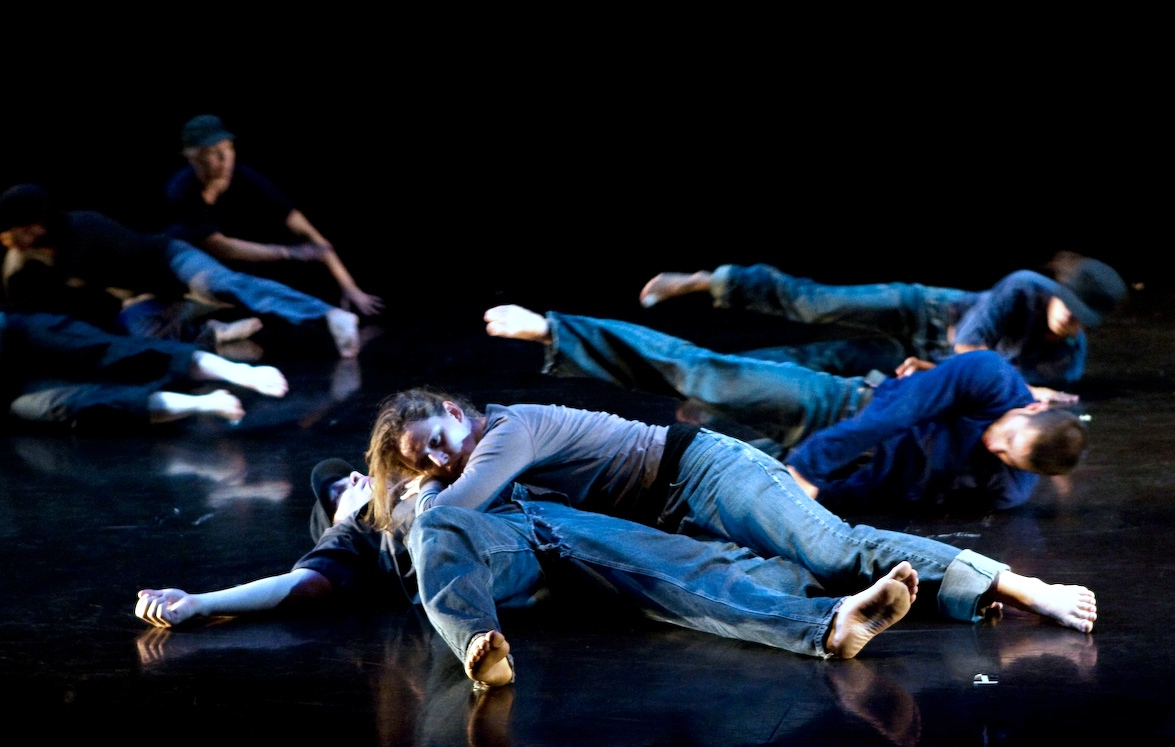
PRESS
Artistic Director, Carl Flink at ADF in 2014!
BLM is excited to announce that our artistic director Carl Flink will spend six and a half weeks in residence at the American Dance Festival (ADF) in Durham, NC in June-July 2014. He will create a new work using dancers from the prestigious ADF Six Week School. His new work will premiere at the Festival on a shared evening. The ADF, founded in 1934, is an international magnet for choreographers, dancers, teachers, critics, musicians and scholars, and has been deemed “one of the most important institutions in the history of American dance” by Washington Post.
Flying Through Space: BLM in Dance Magazine 2014
By: Linda Shapiro
Read the article and see photos in Dance Magazine here.
Black Label Movement gives new meaning to risky behavior. Coming from a serious soccer background, founder Carl Flink has what he describes as “a commitment to flying into space without being worried about the impact.” Onstage, his dances explore wildly physical action and dramatic subjects, such as the fate of people trapped in an airtight compartment of a sinking ship. Offstage, his collaborations with scientists have used dance to simulate molecular processes and navigate zero-gravity environments—and have become a sensation at TED Talks, the global big ideas conferences.
“When I was young, movement was about running, jumping, falling, catching,” Flink says. “I never want to lose that passion to move, to be alive in my skin.”
That full-throttle approach has made Flink into a dream choreographer for a certain kind of adrenaline-junkie dancer. “I’d never seen movement done that way—so visceral, dynamic, big,” says Lauren Baker, who studied under Flink at the University of Minnesota before joining BLM in 2011. “It tore my world apart.”
Presenters are also taking notice: Flink has recently gotten several commissions, and his Twin Cities–based company is increasingly touring beyond Minnesota’s borders. His wide-ranging vision has brought BLM from the concert stage to science laboratories and the viral upper echelons of YouTube.
Flink, who holds a law degree from Stanford University, sees his work as an attempt to “manifest political statements in the work of the body.” He first began taking dance classes at the University of Minnesota while majoring in political science and women’s studies. After graduating in 1990, he performed with the Limón Dance Company in New York for six years, eventually moving back home to Minneapolis to work with the Farmers’ Legal Action Group. He began teaching men’s and partnering classes at the U of M, and in 2004, he left his career in law to become director of the dance program and later chair of the Department of Theatre Arts and Dance.
When Flink launched BLM in 2005, he named the company after generic food brands because of their no-nonsense way of communicating: “I liked those unrelenting black and yellow labels saying exactly what’s inside—like ‘peas.’ ”
Flink also calls his 10 dancers (many of whom are U of M graduates), “movers.” He likens them to surfers trying to find ease riding natural forces they can’t control.
This approach is part of why Flink has become an appealing collaborator for scientists. Biomedical engineer David Odde worked with Flink to develop “bodystorming,” a technique where dancers model scientific theories, such as the tumultuous function of particles in a cell. That led to a dance entitled HIT that explores the impact of bodies colliding and finding, as the Minneapolis Star Tribune put it, “the unexpected poetry within aggression.”
In 2011, BLM and John Bohannon, a Science magazine correspondent and the founder of the annual Dance Your Ph.D. contest, performed A Modest Proposal during TEDx Brussels. The 11-minute presentation examined ways that dance, science and communication could intersect to become an alternative to the dominant medium of PowerPoint. When posted on the main TED website, the video went viral.
That success led to BLM working with Bohannon and the Minneapolis band Jelloslave to create a new presentation for the 2012 TED: Full Spectrum conference. Called “Let’s Talk About Sex,” it discusses how to explain the evolutionary nature of sex to young people. Later that year, Flink’s award-winning choreography for a Twin Cities production of Spring Awakening took some of those ideas to embody adolescent passion and pain, with dancers literally bouncing off of the walls.
Flink demands an extreme intensity from his dancers. There is no marking in his rehearsals. “On one hand, there’s the excitement of dancers moving around in risky and exhilarating ways and pounding on each other,” says Flink. “But by the end, it’s about survival.”
During a rehearsal last September at the Cowles Center for Dance and the Performing Arts in Minneapolis, Flink began a new piece by asking the dancers to create duets based on touch and an “oozing” movement phrase he had taught them. “Can we just see the rawness of where you are?” he asked. Five couples showed a fascinating range of fluid athleticism with hints of aggression, humor and menace. Flink then suggested structures, such as having the group surround a duet and shadow the pelvis of one dancer to create a surging group dynamic. By the end of the hour, dancers were orbiting the central couple at full speed, or crowding in, forcing the pair to break through them.
“Carl allows us to try things without any kind of judgment,” says Baker. “He honors what we come up with and then he shapes it.”
His young company members have taken to Flink’s work voraciously. “They’re so rabid in their desire to move and be challenged,” says Flink. “When I walk into rehearsal, I’d better have my work boots on.”